Swimming naturally reduces your anxiety through multiple calming mechanisms. When you're in the water, the decreased gravity effects and surrounding pressure activate your body's relaxation response, while controlled breathing mirrors meditation techniques. Your brain releases mood-boosting chemicals like endorphins, serotonin, and GABA – creating a natural antidepressant effect that can last for hours after your swim. The rhythmic movements and water's buoyancy help release physical tension, while the regulated temperature (78-82°F) promotes deep relaxation. The science behind swimming's anxiety-reducing effects reveals a powerful yet gentle solution for mental wellness.
The Science Behind Water Therapy
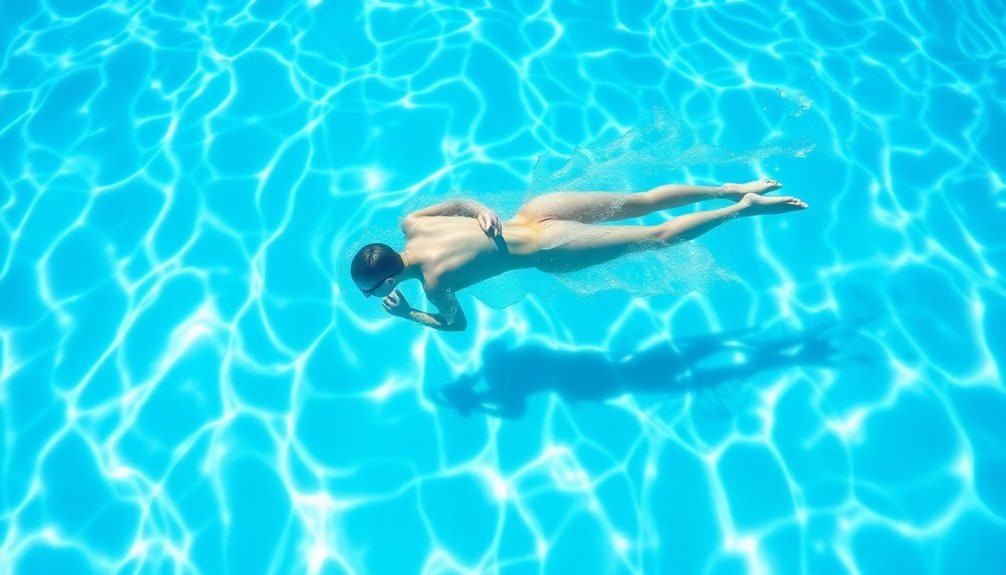
Water therapy's calming effects stem from the physical and neurological responses triggered when your body is submerged. When you're in water, your body experiences a decrease in gravity's effects, reducing physical tension and leading to immediate muscular relaxation.
The pressure of water against your skin activates your parasympathetic nervous system, which controls your body's "rest and digest" response. The rhythmic movement of swimming releases endorphins and increases the production of neurotransmitters like serotonin and dopamine.
These brain chemicals play significant roles in mood regulation and stress reduction. You'll also benefit from the controlled breathing patterns required during swimming, which mirror meditation techniques and help lower cortisol levels.
Research shows that being in water at chest level reduces your body's stress hormones by up to 14%. The water's temperature matters too – when you're in cool water, your body increases blood circulation to maintain warmth, delivering more oxygen to your brain and enhancing mental clarity.
This combination of physiological responses creates a natural anti-anxiety effect that you can't easily replicate with land-based exercises.
Swimming's Impact on Brain Chemistry
When you swim, your brain naturally releases endorphins that act as powerful mood elevators and stress reducers.
Your aquatic workout triggers increased production of GABA, a neurotransmitter that helps calm anxious thoughts and promote mental clarity.
The rhythmic movements and water immersion during swimming boost your serotonin levels, creating a natural antidepressant effect that can last hours after you leave the pool.
Natural Endorphin Release Mechanism
Swimming triggers a powerful cascade of endorphins in your brain, acting as natural mood elevators and stress reducers. When you're immersed in water and moving your body, your nervous system activates specific pathways that release these "feel-good" chemicals. You'll experience this natural high within 20-30 minutes of sustained swimming.
| Endorphin Effect | Anxiety Reduction Benefit |
|---|---|
| Beta-endorphin release | Decreases stress hormones |
| Dopamine surge | Improves mood and motivation |
| Serotonin boost | Enhances emotional stability |
| GABA production | Calms racing thoughts |
| Norepinephrine balance | Increases mental clarity |
Your body's endorphin production doesn't stop when you leave the pool. You'll continue experiencing these benefits for several hours after swimming, as your brain maintains elevated levels of these natural compounds. The rhythmic nature of swimming strokes enhances this effect, creating a meditation-like state that maximizes endorphin release. You'll find that regular swimming sessions can help establish a more balanced endorphin system, leading to better anxiety management even on days when you're not in the water.
GABA Production While Swimming
Among the brain's chemical responses to swimming, GABA (gamma-aminobutyric acid) production stands out as a powerful anxiety-fighting mechanism. When you're swimming, your brain increases its GABA production, which acts as a natural tranquilizer by blocking stress-related neural signals and calming your nervous system.
The repetitive motions and rhythmic breathing patterns you maintain while swimming trigger your brain to optimize GABA production. This neurotransmitter helps reduce anxiety by:
- Slowing down racing thoughts by decreasing neural activity in overactive regions of your brain
- Relaxing your muscles through improved neural signaling, which reduces physical tension typically associated with stress
- Promoting a sense of mental clarity by regulating the intensity of anxiety-producing signals
You'll notice GABA's effects within 20-30 minutes of swimming, as your mind becomes calmer and your thoughts more organized.
This chemical response isn't temporary – regular swimming sessions can help your brain maintain healthy GABA levels throughout the day, leading to better long-term anxiety management.
The combination of physical activity and increased GABA production makes swimming particularly effective for anxiety relief.
Serotonin and Water Exercise
In addition to GABA, your brain releases elevated levels of serotonin during and after swimming sessions. When you immerse yourself in water and begin moving, your brain's chemistry shifts, producing more of this essential neurotransmitter that regulates mood, anxiety, and happiness.
The rhythmic movements of swimming, combined with the water's pressure on your body, trigger enhanced serotonin production.
You'll notice the effects of increased serotonin both during and after your swim. While you're in the water, you might experience improved mood and reduced anxiety. The boost in serotonin continues working even after you've left the pool, contributing to better sleep quality and a more stable emotional state throughout your day.
The water temperature also plays a role in serotonin release. Swimming in cool water (around 70-75°F) stimulates your body's stress response system, leading to increased serotonin production as a natural coping mechanism.
Your body adapts to this mild stress by releasing mood-enhancing chemicals, which is why you often feel mentally refreshed and emotionally balanced after a swimming session, even if you're physically tired.
Breathing Techniques While Swimming
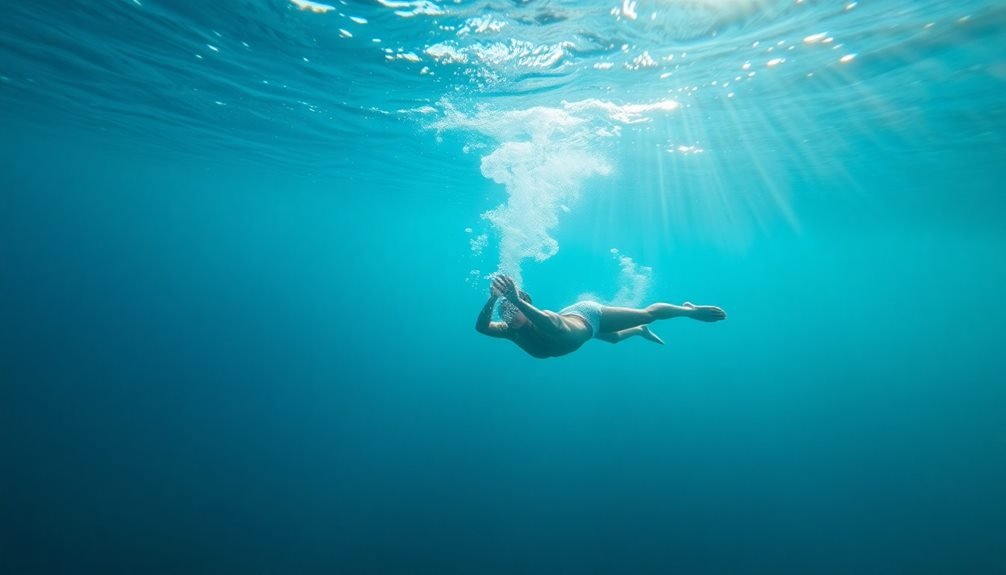
Proper breathing techniques during swimming can transform your anxiety-reducing workout from exhausting to energizing. When you master rhythmic breathing while swimming, you'll create a meditative state that naturally calms your nervous system.
This controlled breathing pattern helps reduce cortisol levels and promotes a sense of peace, similar to practices found in yoga and meditation.
You'll want to establish a consistent breathing rhythm that matches your stroke pattern. For freestyle swimming, breathe every third stroke to maintain balance and prevent oxygen deprivation. The key is to exhale slowly underwater through your nose and mouth, then quickly inhale through your mouth when you turn your head to the side.
Here are three essential breathing techniques to practice:
- Bilateral breathing – alternating sides every third stroke, promoting balanced muscle development and reducing neck strain
- Bubble blowing – exhaling steadily underwater while creating small bubbles, helping establish a controlled breathing rhythm
- Side-glide breathing – pausing in a side position to practice the breath-stroke coordination without movement
These techniques not only improve your swimming efficiency but also enhance the anxiety-reducing benefits of your water workout.
Physical Benefits for Mental Health
Your body undergoes powerful chemical changes during swimming that directly impact your mental wellbeing. When you swim, your brain releases endorphins and serotonin, natural mood elevators that reduce stress and anxiety. These neurotransmitters help create a sense of calm and happiness that can last for hours after you've left the pool.
Swimming's rhythmic movements and resistance training strengthen your muscles while burning calories, which helps regulate your body's cortisol levels. You'll notice improved sleep patterns and increased energy throughout the day, both essential factors in managing anxiety.
The water's buoyancy also reduces joint pressure and muscle tension, allowing your body to release physical stress that often accompanies mental distress.
As you exercise in water, your body temperature changes help regulate your nervous system, leading to decreased anxiety symptoms. The combination of cardiovascular exercise and gentle resistance builds physical resilience, which directly correlates to mental resilience.
You'll develop stronger lungs and a healthier heart, increasing oxygen flow to your brain and enhancing cognitive function. These physiological improvements create a foundation for better mental health management and reduced anxiety levels.
Creating Your Personal Aquatic Sanctuary

Swimming alongside others can provide social benefits, but transforming your pool time into a personal sanctuary amplifies its anxiety-reducing effects.
You'll find that creating your own aquatic retreat isn't just about swimming laps – it's about designing an environment that helps you disconnect from daily stressors and connect with yourself.
To create your personal aquatic sanctuary, consider these elements that engage your senses:
- Choose off-peak hours when the pool is less crowded, allowing the gentle splash of water to become your primary soundtrack rather than others' conversations.
- Focus on the rhythmic patterns of light dancing across the pool's surface, letting the mesmerizing reflections guide your mind to a calmer state.
- Pay attention to the water's embrace as it supports your body, noticing how it seems to wash away tension with each stroke.
You don't need perfect technique or expensive equipment to benefit from this sanctuary.
Instead, concentrate on developing a routine that feels natural to you. Whether you prefer slow, methodical laps or simply floating quietly, make this time exclusively yours, free from external demands and expectations.
Swimming Mindfulness Practices
Once you've established your aquatic sanctuary, incorporating mindfulness practices can deepen your swimming experience and further reduce anxiety. Focus on your breath synchronization with each stroke, noticing how your body moves through the water. Pay attention to the sensation of water flowing across your skin and the rhythmic pattern of your movements.
| Practice | Technique | Benefit |
|---|---|---|
| Breath Focus | Count strokes between breaths | Reduces racing thoughts |
| Body Scan | Notice each muscle group while swimming | Releases physical tension |
| Water Awareness | Feel temperature and resistance | Anchors you to present moment |
While swimming, practice staying present by counting your laps without judgment. If your mind wanders, gently bring your attention back to your breath and movement. You'll find that combining these mindfulness techniques with swimming creates a moving meditation that quiets anxious thoughts. Try focusing on one mindfulness practice per session until it becomes natural, then gradually incorporate others. Remember that consistency matters more than perfection – even a few minutes of mindful swimming can help calm your nervous system and reduce stress levels.
Getting Started in the Pool
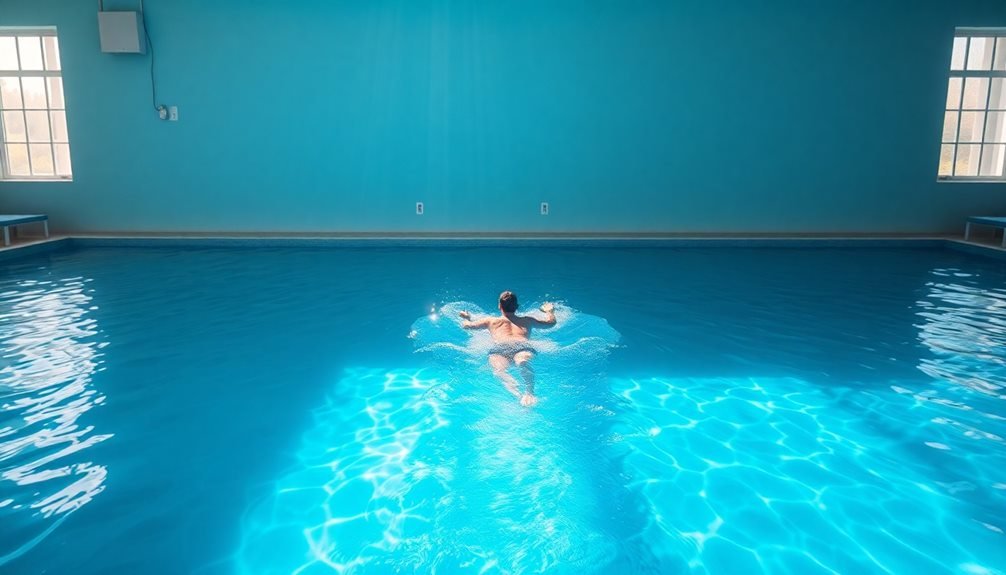
Before diving into a swimming routine, it's essential to prepare yourself properly for success in the pool. You'll want to gather essential equipment, including a well-fitting swimsuit, goggles that don't leak, and a swim cap to protect your hair from chlorine.
Start with shorter sessions of 15-20 minutes to build your comfort level and endurance gradually. If you're new to swimming or haven't been in the water for a while, consider taking a few beginner lessons to master proper form and breathing techniques. You'll feel more confident knowing you're using correct strokes and maintaining efficient body position in the water.
- Begin in the shallow end, practicing floating and getting comfortable with water on your face while holding the pool's edge.
- Move on to basic freestyle arm movements while walking in chest-deep water, focusing on your breathing rhythm.
- Practice gliding from wall to wall with your face in the water, taking regular breaths by turning your head to the side.
Remember to listen to your body and progress at your own pace. There's no rush to become an expert swimmer overnight.
Social Aspects of Swimming
You'll find that swimming classes offer more than just technique instruction – they create natural opportunities to meet others who share your interest in aquatic fitness.
The poolside environment promotes easy conversations between laps, and you're likely to form friendships with classmates who understand your fitness journey.
These social connections can grow into a supportive network that celebrates your progress and keeps you motivated through challenging workouts.
Swimming Classes Build Bonds
Swimming classes bring people together in unique ways that extend beyond the pool. You'll find yourself naturally bonding with fellow swimmers as you share the journey of learning new techniques and overcoming challenges.
The supportive environment of a swimming class creates lasting friendships, especially when you're working through similar anxieties about water or mastering difficult strokes.
When you join a swimming class, you'll experience these connection-building moments:
- Celebrating each other's achievements, from the first successful lap to mastering the butterfly stroke, creating a shared sense of accomplishment
- Supporting one another through challenging drills with words of encouragement and tips, fostering trust and mutual respect
- Engaging in pre and post-class conversations about progress, goals, and everyday life, developing relationships that often continue outside the pool
The structured environment of swimming lessons provides natural conversation starters and shared experiences.
You'll discover that working toward common goals while learning water safety and technique creates an instant community. These bonds often strengthen over time as you progress through different skill levels together, turning casual acquaintances into workout buddies and friends.
Poolside Community Support
While exercise itself can lift your mood, the poolside community adds an extra layer of emotional support to your swimming routine.
You'll find yourself surrounded by like-minded individuals who share your commitment to health and wellness, creating natural opportunities for meaningful connections.
At the pool, you'll encounter regular swimmers who become familiar faces and eventual friends.
These relationships often extend beyond the water, as you'll find yourself sharing tips, discussing progress, and offering mutual encouragement.
Whether you're working through anxiety or just having a tough day, your pool companions can provide understanding and support.
The poolside environment also offers a unique social setting where you don't have to maintain constant conversation.
You can engage with others between laps, during water breaks, or in the locker room, making it less overwhelming than traditional social situations.
Many pools host informal gatherings, swim clubs, or morning coffee meetups, giving you additional chances to strengthen these connections.
You'll discover that this built-in support system becomes an essential part of your anxiety management strategy, combining the physical benefits of swimming with valuable social interaction.
Water Temperature and Stress Relief
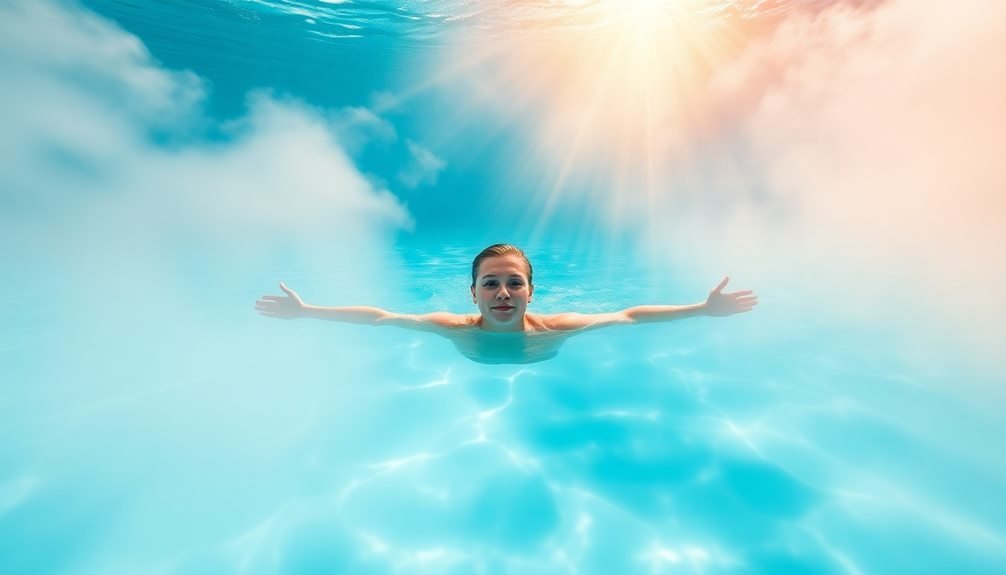
Research points to a strong connection between water temperature and anxiety reduction during pool sessions. When you swim in water maintained between 78-82°F (25.5-27.7°C), your body experiences ideal conditions for both exercise and relaxation. This temperature range helps regulate your core body temperature while preventing the additional stress of feeling too cold or overheated.
You'll notice these calming effects when swimming in properly heated water:
- Your muscles gradually relax as the water's warmth penetrates deep into your tissue, releasing physical tension that often accompanies anxiety.
- Your breathing naturally slows down as the moderate temperature allows for comfortable rhythmic movements without gasping for air.
- Your mind becomes clearer as the consistent temperature creates a stable, predictable environment that helps quiet racing thoughts.
The therapeutic benefits increase when you maintain a steady swimming pace in temperature-controlled water.
If you're dealing with chronic anxiety, you'll find that indoor pools offer the most reliable temperature control throughout the year, making them ideal for consistent stress-relief sessions.
Regular exposure to properly heated water can greatly reduce your overall stress levels and improve your mental well-being.
Developing a Swimming Routine
Building on the benefits of temperature-controlled water, you'll want to establish a consistent swimming schedule that maximizes these anxiety-reducing effects. Start with two to three 30-minute sessions per week, gradually increasing to four or five as your comfort and fitness levels improve. Choose times when the pool isn't crowded, allowing you to focus on your movements without distraction.
Begin each session with five minutes of gentle floating or slow swimming to acclimate your body to the water. Then, alternate between different strokes – breaststroke for meditation-like rhythm, backstroke for sky-gazing relaxation, and freestyle for cardiovascular benefits. You don't need to swim continuously; take brief rests at the pool's edge when needed.
Track your progress using a waterproof fitness watch or pool-side journal, noting how you feel before and after each swim. Set realistic goals that focus on consistency rather than speed or distance. If you're new to swimming, consider taking lessons to improve your technique and boost confidence.
Remember to end each session with five minutes of relaxed swimming or floating, allowing your mind and body to fully absorb the anxiety-reducing benefits.
Managing Panic Through Movement
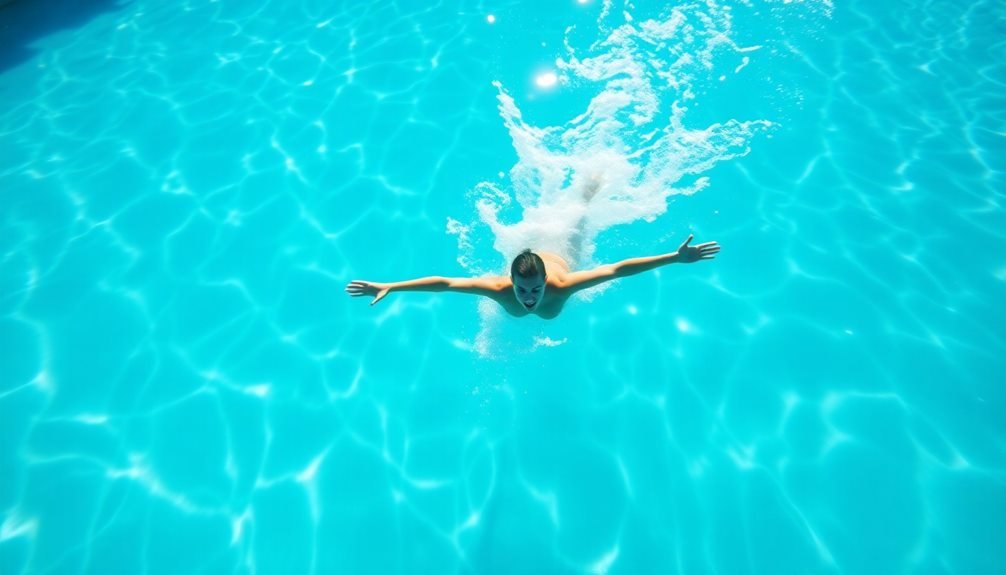
Swimming releases powerful anti-panic techniques through purposeful movement in water. When you feel anxiety rising, the controlled movements of swimming can help redirect your mind from racing thoughts to rhythmic motion. The water's gentle pressure against your skin creates a natural grounding effect, helping you stay present in the moment rather than spiraling into panic.
As you move through the water, you'll notice how swimming naturally incorporates key anti-anxiety practices:
- Your breathing becomes regulated with each stroke, forcing you to inhale and exhale in a measured pattern that mimics meditation techniques.
- Your muscles engage in repetitive motions that release tension and produce endorphins, creating a natural calming effect.
- Your body experiences a weightless sensation that reduces physical stress on joints and promotes a feeling of freedom.
You don't need to be an expert swimmer to benefit from these effects. Even simple movements like water walking or floating can help manage panic symptoms.
The key is to focus on how your body feels as it moves through the water, letting the aquatic environment support your journey toward calm.
Frequently Asked Questions
Can Swimming Help With Anxiety if I'm Not a Strong Swimmer?
Yes, you'll still benefit from gentle swimming at your own pace. Even basic water movements like treading or walking in shallow water can help reduce your anxiety through rhythmic motion and controlled breathing.
What Time of Day Is Best for Anxiety-Reducing Swimming Sessions?
You'll get the most anxiety-reducing benefits from swimming in the early morning or late evening when pools are quieter. If you're new to swimming, start with shorter sessions when you're feeling most energetic.
How Long Should I Wait After Eating Before Swimming for Anxiety Relief?
You'll want to wait 2-3 hours after a large meal or 30 minutes after a light snack before swimming. This helps prevent cramps and discomfort while letting you focus on your anxiety-reducing swim session.
Are Indoor or Outdoor Pools Better for Managing Anxiety Symptoms?
Both pool types can help your anxiety, but outdoor pools offer added benefits of sunlight and nature. You'll get vitamin D and fresh air outside, while indoor pools provide year-round consistency and privacy.
Does Swimming With Contact Lenses Affect the Anxiety-Reducing Benefits of Swimming?
You'll still get anxiety-reducing benefits while swimming with contacts, but you should wear goggles to protect them. It's best to contemplate switching to prescription goggles for a worry-free swim session.
In Summary
You'll find swimming offers a unique path to managing anxiety that combines gentle movement, controlled breathing, and the soothing properties of water. When you're consistent with your swimming routine, you're giving yourself a powerful tool for stress relief and mental clarity. Whether you choose to swim alone or join group sessions, you're taking an important step toward better mental health through this natural, low-impact therapy.

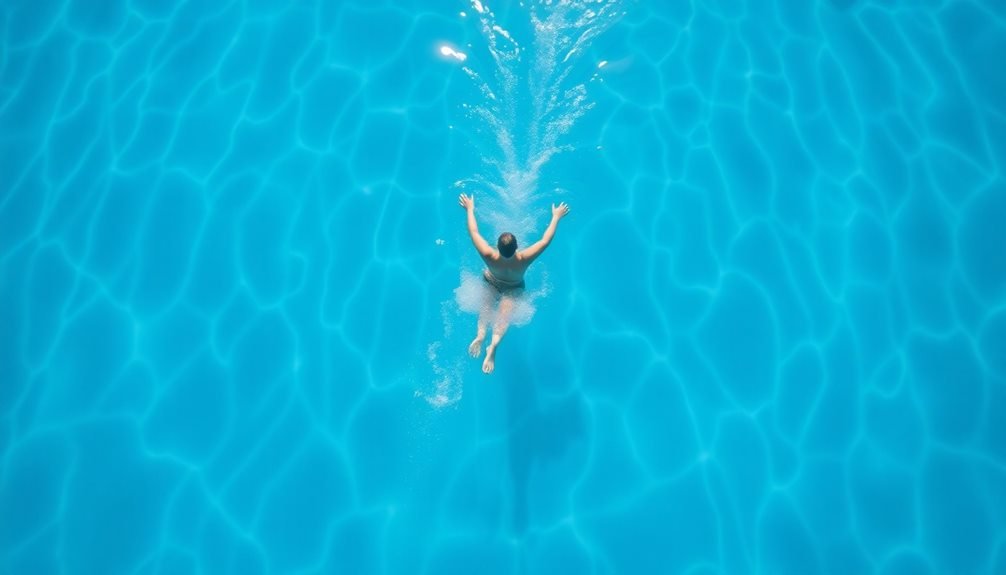

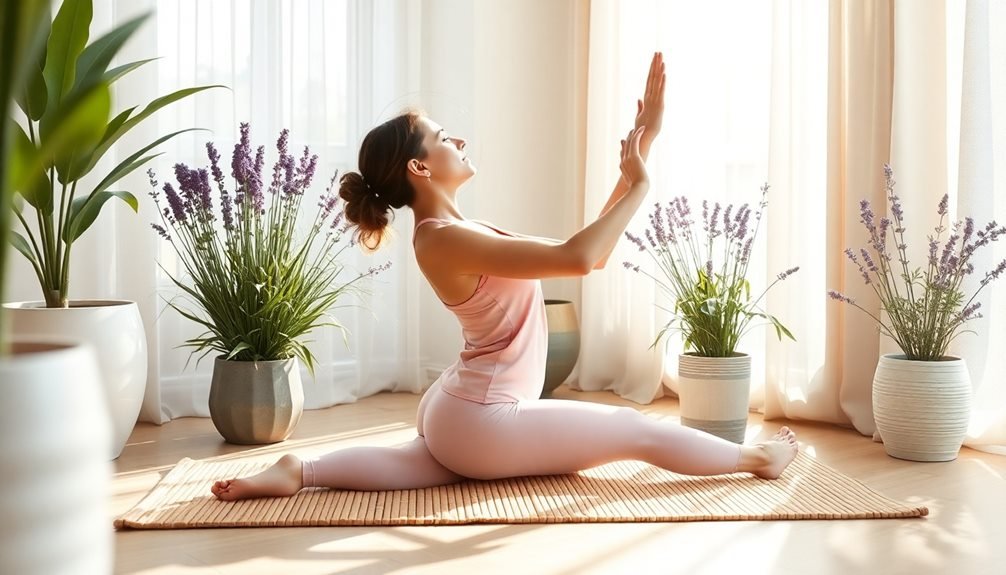
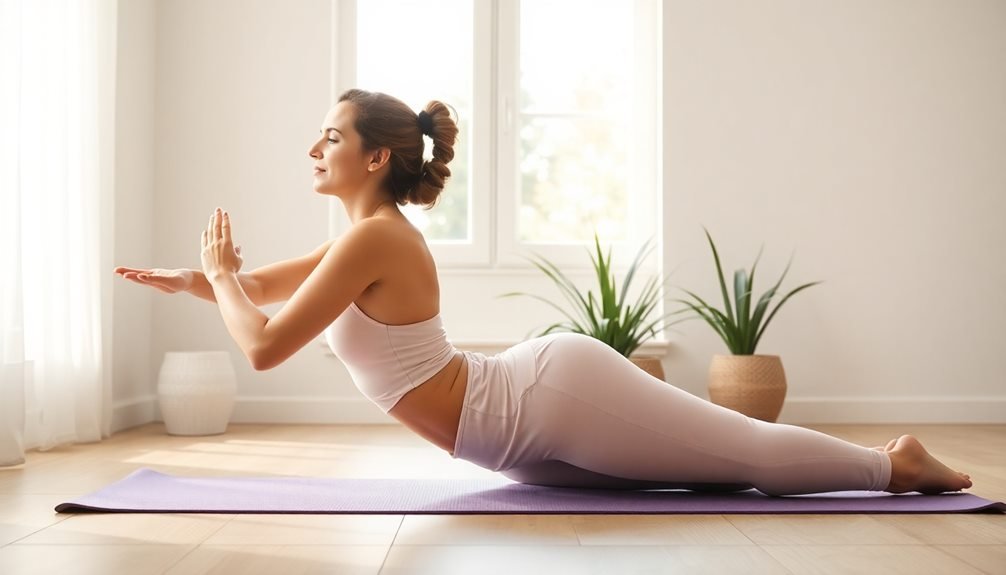
Leave a Reply